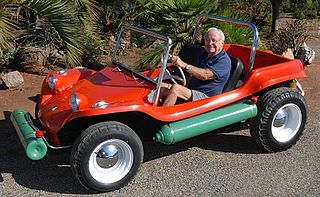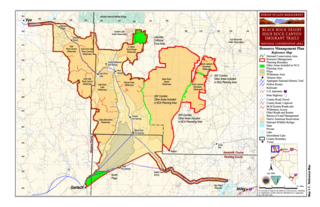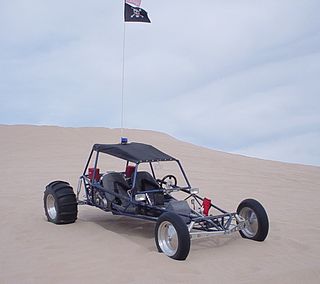
A solid-propellant rocket or solid rocket is a rocket with a rocket engine that uses solid propellants (fuel/oxidizer). The earliest rockets were solid-fuel rockets powered by gunpowder; they were used in warfare by the Arabs, Chinese, Persians, Mongols, and Indians as early as the 13th century.

A dune buggy — also known as a beach buggy — is a recreational motor vehicle with large wheels, and wide tires, designed for use on sand dunes, beaches, roads or desert recreation.
Radio-controlled cars are miniature model cars, vans, buses, trucks or buggies that can be controlled from a distance using a specialized transmitter or remote. The term "RC" has been used to mean both "remote controlled" and "radio controlled", where "remote controlled" includes vehicles that are controlled by radio waves, infrared waves or a physical wire connection. Common use of "RC" today usually refers only to vehicles controlled by radio, and this article focuses on radio-controlled vehicles only.

A model rocket are small rockets designed to reach low altitudes and be recovered by a variety of means.

A scale model is a physical model which is geometrically similar to an object. Scale models are generally smaller than large prototypes such as vehicles, buildings, or people; but may be larger than small prototypes such as anatomical structures or subatomic particles. Models built to the same scale as the prototype are called mockups.

The Black Rock Desert is a semi-arid region of lava beds and playa, or alkali flats, situated in the Black Rock Desert–High Rock Canyon Emigrant Trails National Conservation Area, a silt playa 100 miles (160 km) north of Reno, Nevada that encompasses more than 300,000 acres (120,000 ha) of land and contains more than 120 miles (200 km) of historic trails. It is in the northern Nevada section of the Great Basin with a lakebed that is a dry remnant of Pleistocene Lake Lahontan.

Estes Industries is a model rocket company that was started in Denver, Colorado, USA. The company was the first to mass-produce model rocket engines with consistent and reliable performance. It is popular among hobbyists of experimental amateur rocketry for its simple and easily accessible engines, accessories, and rocket-building kits.

Homebuilt aircraft, also known as amateur-built aircraft or kit planes, are constructed by persons for whom this is not a professional activity. These aircraft may be constructed from "scratch", from plans, or from assembly kits.

The Meyers Manx dune buggy is a small recreationally-oriented automobile, designed initially for desert racing by Californian engineer, artist, boat builder and surfer Bruce F. Meyers. It was produced by his Fountain Valley, California company, B. F. Meyers & Co. from 1964 to 1971, in the form of car kits applied to shortened chassis of Volkswagen Beetles. The car line dominated dune racing in its time, breaking records immediately, and was eventually also released in street-oriented models, until the company's demise due to tax problems after Meyers's departure. New vehicles inspired by the original Manx buggy have been produced by Meyers's re-founded operation, Meyers Manx, Inc., since 2000. The name and cat logo of the brand derives from the Manx cat, by virtue of the tailless breed's and the shortened vehicle's truncated "stubbiness".

A sandrail, or sand rail, or rail, is a lightweight off-road motor vehicle specifically built for traveling in sandy terrain. Similar in some respects and often mistakenly referred to as a dune buggy or sand car, a sandrail is a different type of speciality vehicle. Sandrails are popularly operated on actual sand dunes. Sandrails can be driven on other types of terrain but are designed specifically for sand.

High-power rocketry is a hobby similar to model rocketry. The major difference is that higher impulse range motors are used. The National Fire Protection Association (NFPA) definition of a high-power rocket is one that has a total weight of more than 1,500 grams (3.3 lb) and contains a motor or motors containing more than 125 grams (4.4 oz) of propellant and/or rated at more than 160 Newton-seconds of total impulse, or that uses a motor with an average thrust of 80 newtons (18 lbf) or more.
Motors for model rockets and high-powered rockets are classified by total impulse into a set of letter-designated ranges, from ⅛A up to O. The total impulse is the integral of the thrust over burn time.
Amateur rocketry, sometimes known as experimental rocketry or amateur experimental rocketry, is a hobby in which participants experiment with fuels and make their own rocket motors, launching a wide variety of types and sizes of rockets. Amateur rocketeers have been responsible for significant research into hybrid rocket motors, and have built and flown a variety of solid, liquid, and hybrid propellant motors.

The Volkswagen Country Buggy is a small utility vehicle designed and built by Volkswagen in Australia. It used parts from the existing Type 1 and Type 2. Production ran from 1967 to 1968. A derivative of the Country Buggy called the Sakbayan was built in the Philippines for several years until 1980.

The Dakar 4x4 is a kit car - the successor of the Rotrax - though unlike many it is based on a Range Rover chassis rather than the more usual sports car style. Originally developed in 1991 by Barry Chantler of Dakar Cars in Dartford, Kent, they are now manufactured and built to order by Steve Bennett's company Dakar 4×4 in Melton Mowbray, Leicestershire. There are around 120 known conversions in the UK, with more in the Netherlands and also the similar Bush Ranger ("Bushie") in Australia.
Kyosho Corporation is a Japanese company based in Tokyo, which operates internationally under the name KYOSHO. The company's main office is located in Chiyoda, and the production headquarters are located in Atsugi, Kanagawa.

The Civilian Space eXploration Team, known as CSXT, is a team of around 30 civilians interested in private spaceflight. The team was created by Ky Michaelson. Having conducted multiple rocket launches in an attempt to establish altitude records, CSXT became the first entity to officially launch an amateur rocket into space on May 17 2004, with the successful launch of its GoFast rocket to 116 km altitude, an altitude verified by FAA analysis of the team's flight data.
Ammonium perchlorate composite propellant (APCP) is a modern fuel used in solid-propellant rocket vehicles. It differs from many traditional solid rocket propellants such as black powder or zinc-sulfur, not only in chemical composition and overall performance but also by the nature of how it is processed. APCP is cast into shape, as opposed to powder pressing as with black powder. This provides manufacturing regularity and repeatability, which are necessary requirements for use in the aerospace industry.
The United Kingdom Rocketry Association (UKRA) is an enabling body set up to promote and represent high power, medium power and model rocketry in the United Kingdom for educational, recreational and amateur research purposes. UKRA is also the specialist body to the BMFA with responsibilities for High Power Rocketry, and is the United Kingdom body recognized by the Civil Aviation Authority.

A monocopter or gyropter is a rotorcraft that uses a single rotating blade. The concept is similar to the whirling helicopter seeds that fall from some trees. The name gyropter is sometimes applied to monocopters in which the entire aircraft rotates about its center of mass as it flies. The name "monocopter" has also been applied to the personal jet pack constructed by Andreas Petzoldt.






















